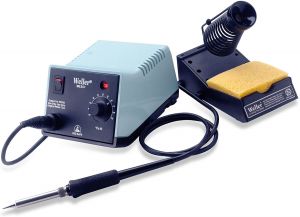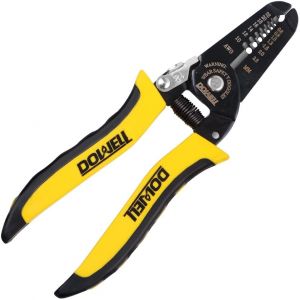Difference between revisions of "Tools For Beginners"
| Line 10: | Line 10: | ||
For smaller robots you can get by with a pair of scissors to cut your wires and a sharp knife to strip off the insulation but it can be difficult to strip the insulation without damaging the underlying wire. Things will be much easier if you have the right tool for the job. There are several different varieties but you can get a fully functional pair for just a few dollars. The 'automatic' wire strippers tend to work better for larger gage wires plyer style can work better for smaller wires.<br> | For smaller robots you can get by with a pair of scissors to cut your wires and a sharp knife to strip off the insulation but it can be difficult to strip the insulation without damaging the underlying wire. Things will be much easier if you have the right tool for the job. There are several different varieties but you can get a fully functional pair for just a few dollars. The 'automatic' wire strippers tend to work better for larger gage wires plyer style can work better for smaller wires.<br> | ||
<br> | <br> | ||
| − | <strong>Drivers</strong><br> | + | <strong>Drivers / Wrenches</strong><br> |
| + | Nearly all bots use some fasteners to hold things together. Hex key or Allen key fasteners are the most popular since the fastener heads aren't as susceptible to damage as phillips head fasteners. These come in many different styles and lengths for different uses. If your bot design requires you to remove a lot of fasteners to access the internals, consider getting a set that can attach to an electric drill or screwdriver.<br> | ||
| + | <br> | ||
| + | <strong>Drills</strong><br> | ||
<br> | <br> | ||
<strong>Saws</strong><br> | <strong>Saws</strong><br> | ||
Revision as of 17:03, 24 April 2021
Builders with years of experience often find themselves in need of a new tool or device to build or run their robot but there are a few things that all builders, even people using robot kits, will need.
Soldering Station
Mastering soldering can be difficult but if you don't have the right tools, even with many hours of practice you'll never become proficient. There are a lot of beginners guides to help you with the basics. There are a lot of inexpensive and worthless soldering stations out there. You don't need to break the bank but you should get a quality tool from a manufacturer like Weller or Hakko or X-Tronic. There are a lot of online guides comparing soldering stations.
The heat from soldering can sometimes damage components. One of the best ways to avoid this is to use leaded 60/40 (60% tin, 40% lead) rosin core solder. Some places will advocate for using lead-free solder but it's melting point is much higher and is much more difficult to use. Another thing to consider getting is a pair of Helping Hands. Typically you will need to hold onto three or four pieces (wire, motor, solder, iron) to solder and this can be difficult with two hands. Helping Hands will hold the pieces you are soldering together for you so you can concentrate on just getting a good solder joint.
Wire Cutters - Strippers
For smaller robots you can get by with a pair of scissors to cut your wires and a sharp knife to strip off the insulation but it can be difficult to strip the insulation without damaging the underlying wire. Things will be much easier if you have the right tool for the job. There are several different varieties but you can get a fully functional pair for just a few dollars. The 'automatic' wire strippers tend to work better for larger gage wires plyer style can work better for smaller wires.
Drivers / Wrenches
Nearly all bots use some fasteners to hold things together. Hex key or Allen key fasteners are the most popular since the fastener heads aren't as susceptible to damage as phillips head fasteners. These come in many different styles and lengths for different uses. If your bot design requires you to remove a lot of fasteners to access the internals, consider getting a set that can attach to an electric drill or screwdriver.
Drills
Saws

